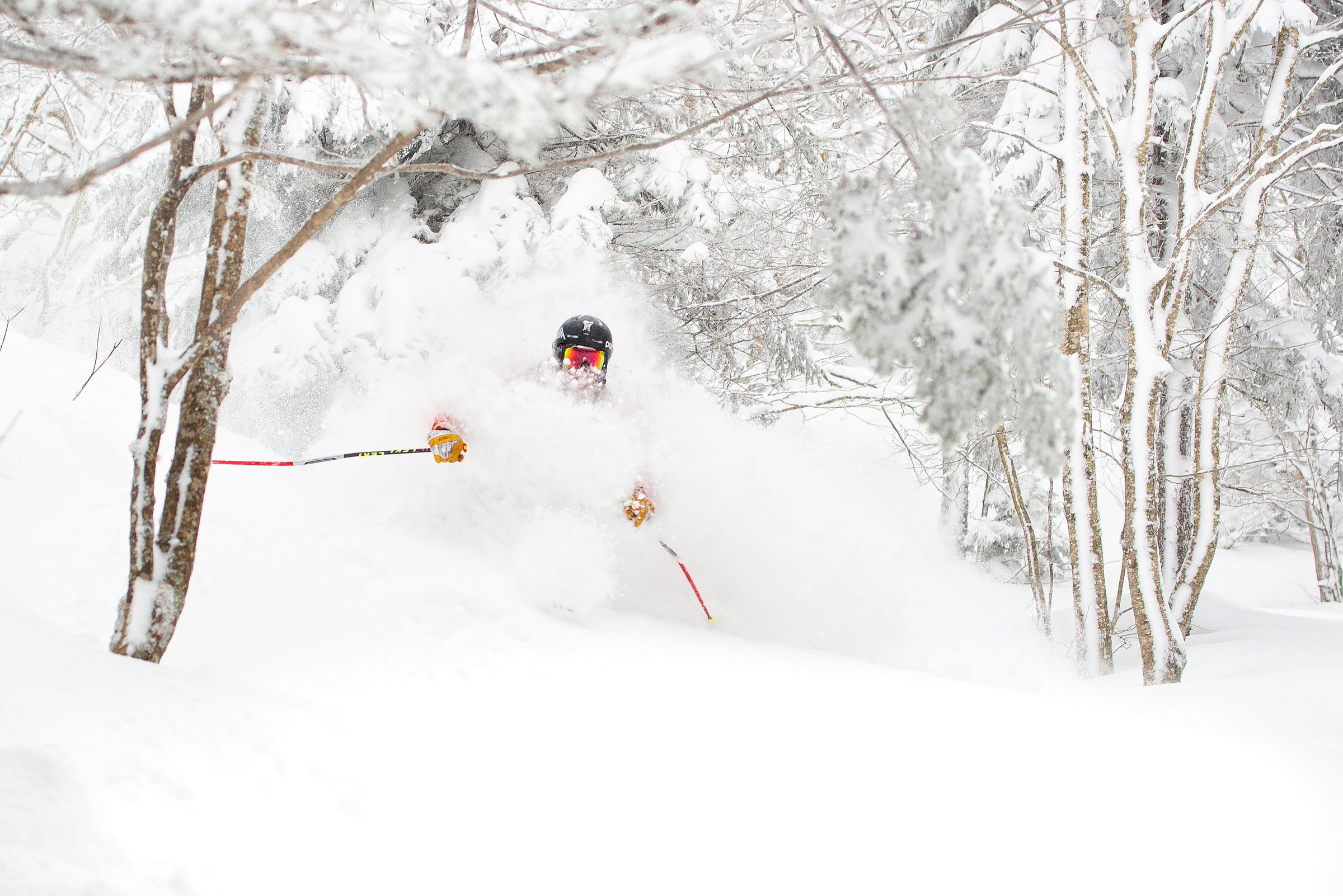Who
Steve Wright, President and General Manager of Jay Peak, Vermont
Recorded on
September 16, 2022
About Jay Peak
Click here for a mountain stats overview
Owned by: Pacific Group Resorts (pending court and regulatory approval)
Pass affiliations: Indy Pass
Located in: Jay, Vermont
Closest neighboring ski areas: Owl’s Head (1/2 hour), Burke (1 hour), Smugglers’ Notch (1 hour), Stowe (1 hour) - travel times approximate and will vary by season and, in the case of Owl’s Head, be heavily dependent upon international border traffic.
Base elevation: 1,815 feet
Summit elevation: 3,968 feet
Vertical drop: 2,153 feet
Skiable Acres: 385
Average annual snowfall: 359 inches
Trail count: 81 (20% novice, 40% intermediate, 40% advanced)
Lift count: 9 lifts (1 tram, 1 high-speed quad, 3 fixed-grip quads, 1 triple, 1 double, 2 carpets – view Lift Blog’s inventory of Jay Peak’s lift fleet)

Why I interviewed him
I’m not even sure what else to say here. I’ve probably written more about Jay Peak than any other ski area in the country since launching The Storm in 2019. Most of it goes something like this bit I wrote last month:
If you’re unfamiliar with Jay Peak, think of it as Vermont’s Wolf Creek or Mt. Baker: big, rowdy, snowy, and affordable. And, for most of us, far away – the resort sits just four miles from the Canadian border. Jay averages more snow than any other ski area east of the Rockies: 359 inches per year. That’s a lot of inches. More than Telluride or Vail or Aspen or A-Basin or Park City. Of course, none of those mountains’ base areas sits at 1,800 feet, as Jay’s does, meaning the whole New England menu of rain, freeze-thaws, and New Yorkers. But it’s enough snow that the place is legendary for glades, typically pushes the season into May, and is one of the only places in New England where you can rack shots like this without the assistance of Photoshop:
From a pure skiing point of view, Jay is, more days than not, the best ski area in the eastern United States. Getting a good powder day in New England is like finding a good banana: it happens a lot less often than you would think, but damn is it satisfying when you do. Jay delivers more bananas than anywhere else in Vermont, a state rippling with snowy legends like Sugarbush and Mad River Glen and Stowe and Smugglers’ Notch. It’s special.
That’s not hyperbole. Jay Peak has led Indy Pass redemptions for the past two seasons not simply because it sits at the top of the nation’s most densely populated region, but because it’s a kick-ass mountain.
But there are a lot of kick-ass mountains in New England that don’t get the love that Jay does. At some point in the skier-snowfall-terrain-cost-stoke algorithm, that maximally boring category called management supersedes the actual skiing in determining public perception of a mountain. For the past six years, Jay Peak has somehow done everything right while everything has gone wrong. In short: the former owners scammed foreign investors out of hundreds of millions in one of the largest immigrant visa scams in U.S. history, the resort tussled with the town over valuation, Vail came to town, Alterra followed, Covid hit, the Canadian border closed, and the whole sales process drug on and on and on. And yet, I’m not sure if the resort’s reputation has ever been stronger, its general more respected, its status as the king of New England skiing more secure.
And while he will be the last one to admit it, that’s almost entirely due to the leadership of Steve Wright, who found himself suddenly thrust into the general manager role as former resort president Bill Stenger was escorted out the door by federal authorities.
What we talked about
Relief; community reaction to Pacific Group Resorts’ (PGRI) winning bid to purchase Jay Peak; how much it helps that PGRI already owns Ragged, a New England ski area; reflecting back on this long slow road; why that road was so long; what finally pushed the sales process to its conclusion; how the pool of potential buyers reacted when PGRI made their initial $58 million bid public; the frantic period between PGRI’s bid on Aug. 1 and the Sept. 7 auction; auction day; what we know about the two bidders who lost out to PGRI; the final legal formalities that PGRI needs to clear to take final ownership of Jay; what Wright means when he says that PGRI shares Jay’s “values”; “You look at an outfit like Pacific, and they’ve lived it”; whether “Jay will stay Jay,” and what that means; how much autonomy PGRI grants its resort managers; turning the resort around with everything working against them; a realm in which modesty rules; Jay’s immediate capital needs; an interesting potential chairlift switcheroo; whether Bonaventure could get an upgrade to a detachable lift, and whether that would be a quad or a six-pack; thoughts on the future of the Indy Pass at Jay Peak; whether Jay Peak will continue to offer affordable lift tickets; will Jay continue to stay open into May?; the West Bowl expansion is dead.
Why I thought that now was a good time for this interview
Well. I wasn’t exactly in need of more work to do. The fall podcast lineup is stacked, with the general managers of Pats Peak, Sun Valley, Brundage, Nub’s Nob, Winter Park, Bromley, Monarch, Sundance, and Vail Mountain scheduled through November. I already have an episode recorded with the Colorado Sun’s Jason Blevins, the best ski reporter in the country. But last week, Jay’s six-year run on the front page of skiing’s tabloids appeared near its end, as mini-conglomerate Pacific Group Resorts submitted the winning, $76 million bid in an auction for the ski area.
We’re not quite done here. PGRI’s bid is subject to approval by a U.S. District Court in Florida. But after years of uncertainty, we are clear to start envisioning Jay Peak not as that resort stuck in a crazy limbo, but as a place with a promising future under a proven multi-resort operator. Will Jay stick with Indy? Will Jet continue spinning into May? What will happen with Canada back in the mix? Will Jay continue to offer affordable lift tickets as Stowe nears $200 a day and Killington, Sugarbush, Stratton, Okemo, and Mount Snow sink deeper into the triple digits?
I don’t think anyone really knows. But the person who’s best positioned to shape the answers to these question is Steve Wright, who just guided Jay Peak through one of the most tumultuous periods in modern lift-served skiing.
Questions I wish I’d asked
We had a quick window to make this happen, so this podcast episode is much shorter than the typical Storm Skiing Podcast. I wanted to talk about the Canadian border re-opening and what that meant for Jay and for skiers. I also wanted to get Wright’s reaction to the fact that Jay is no longer an independent ski area, but part of a larger family of resorts. There are so many ways to go with this story, and I am working on a follow-up to get a better sense of how PRGI will approach Jay and the challenges they face as they evolve the ski area.
What I got wrong
I incorrectly stated that Jay Peak’s top 2021-22 lift ticket price was $86 – it was $96, as Wright notes in the interview. I also said PGRI put their “chips” on the table. Should be “cards” I suppose. But I am not Gambling Bro so I’m vulnerable to malapropisms in that realm.
Why you should ski Jay Peak
The Storm was founded in and continues to be anchored in the Northeast. For those readers, I have nothing to say that they don’t already know. You ski Jay because it’s Jay, because doing so gives you the best odds of pretending like you’re in Colorado and not freezing-below-human-understanding New England.
For the rest of you: should you deign to ski the East, set your GPS for Northern Vermont. Run up the whole Green Mountain Spine. Start at Sugarbush, maybe Killington if you want to experience true New England zeal and madness, then work your way north: Mad River Glen, Bolton Valley, Stowe, Smugglers’ Notch, Jay. That’s the best skiing we have. The terrain is varied and wild, stuffed with must-ski lines and pods: Paradise at MRG, the Front Four at Stowe, Castle Rock at Sugarbush, Madonna at Smuggs. All have expansive backcountry options for Uphill Bro. The vertical drops are legit: Killington stands at 3,000 feet; Pico, right next door, at 1,967; Sugarbush is 2,600; MRG, 2,000; Bolton Valley, 1,701; Stowe, 2,360; Smuggs, 2,610; Jay, 2,153. Here, in this zone of snow and cold – each of these resorts averages at least 250 annual inches – is your best chance of open glades and fresh snow, and the lowest chance of rain and surface-killing refreeze.
Be quiet Shoosh Emoji Bro. Anyone who’s skied any of these mountains knows the secret broke out of jail a long time ago. Besides, my encomiums are unlikely to start a mass eastward migration from SLC. But the Eastern reputation, among much of the ski world, is that of an icy realm of unskiable concrete. That happens. But New England skiing – especially Northern Vermont skiing – is good more often than it’s bad. And if you want to bust your own stereotypes wide open, there are worse places to start than this snowy kingdom at the top of America.
More Jay Peak
As I said above, I’ve written a lot about Jay Peak. One of my favorites was this article last November examining why Jay and soul sister Whitefish, Montana keep their lift tickets affordable in an era in which big-mountain peak-day tickets can cost more than a space shuttle launch:
Last month, I wrote a long piece examining Pacific Group Resorts and what Jay could look like as part of their portfolio. One interesting question: PGRI offers a “Mission: Affordable” season pass at four of its five existing mountains. It started at $379 for the 2022-23 season (they are currently $529). Will Jay follow its new sister resorts, or will it, like PGRI’s Mount Washington Alpine out on Vancouver Island, continue to offer passes in its traditional price range (Jay’s early-bird 2022-23 price was $749; the current price is $895 through Oct. 10). I’m working on a follow-up story, but here was my first analysis:
This is Wright’s second time on The Storm Skiing Podcast. His first appearance also coincided with big news – the resort’s signing with the Indy Pass in 2020:
Oddly, I had scheduled that interview months in advance – the Indy Pass announcement was a complete, and fortunate, coincidence. Here’s the story I wrote around that announcement:
And here was my flash reaction to PGRI’s winning bid last Thursday, which I wrote in a Pennsylvania Burger King on a roadtrip lunch break:
The Storm publishes year-round, and guarantees 100 articles per year. This is article 98*/100 in 2022, and number 344 since launching on Oct. 13, 2019. Want to send feedback? Reply to this email and I will answer (unless you sound insane). You can also email skiing@substack.com.















